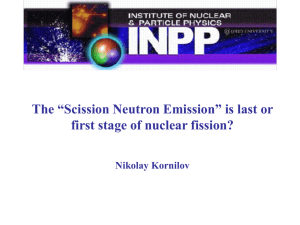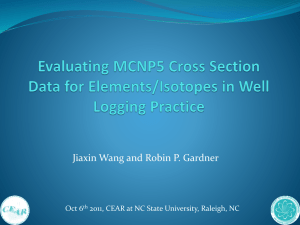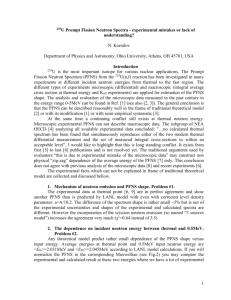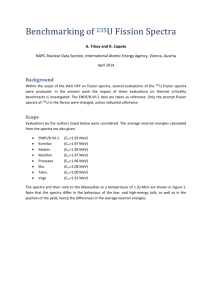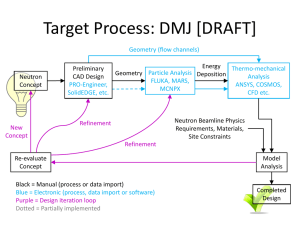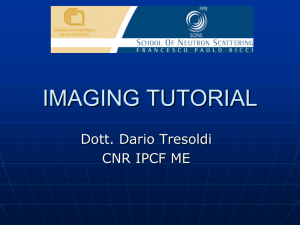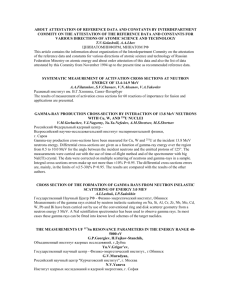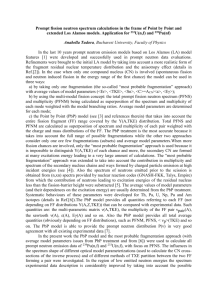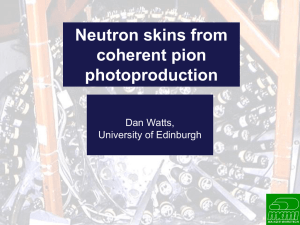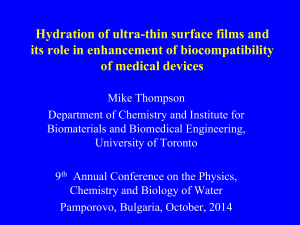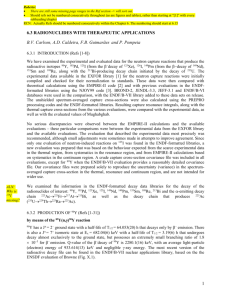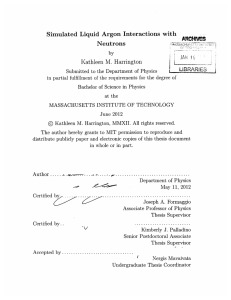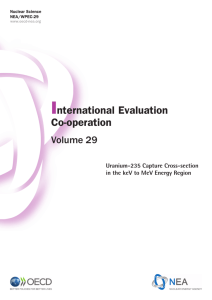Measurements of Angular and Energy Distributions of Prompt
advertisement
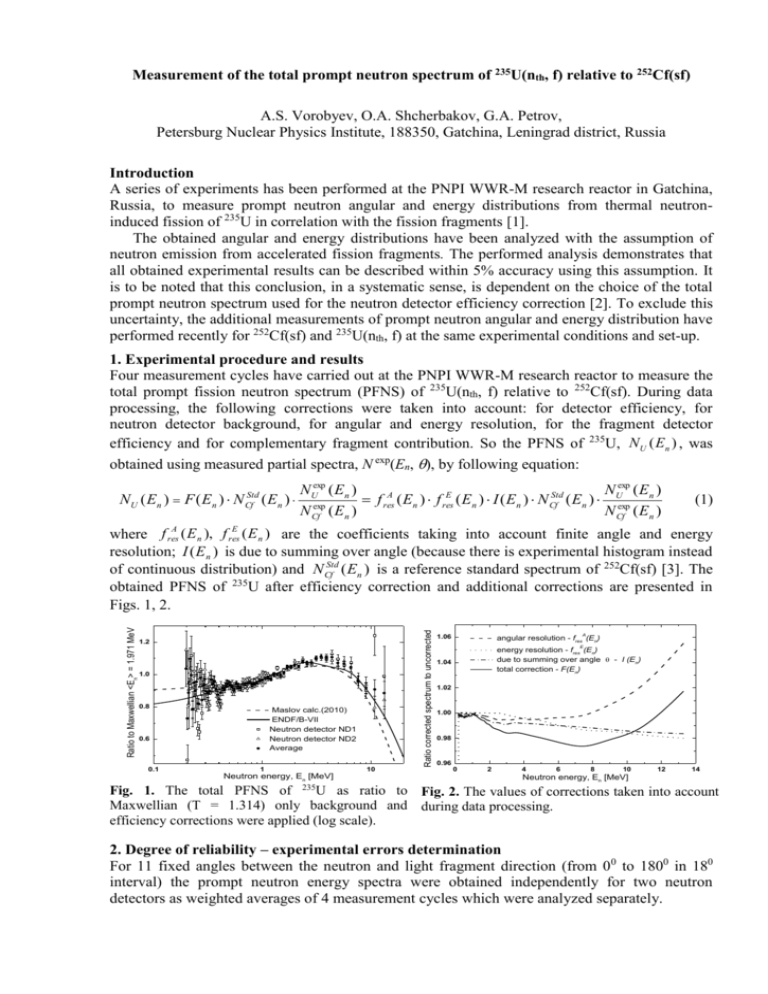
Measurement of the total prompt neutron spectrum of 235U(nth, f) relative to 252Cf(sf) А.S. Vorobyev, О.А. Shcherbakov, G.А. Petrov, Petersburg Nuclear Physics Institute, 188350, Gatchina, Leningrad district, Russia Introduction A series of experiments has been performed at the PNPI WWR-M research reactor in Gatchina, Russia, to measure prompt neutron angular and energy distributions from thermal neutroninduced fission of 235U in correlation with the fission fragments [1]. The obtained angular and energy distributions have been analyzed with the assumption of neutron emission from accelerated fission fragments. The performed analysis demonstrates that all obtained experimental results can be described within 5% accuracy using this assumption. It is to be noted that this conclusion, in a systematic sense, is dependent on the choice of the total prompt neutron spectrum used for the neutron detector efficiency correction [2]. To exclude this uncertainty, the additional measurements of prompt neutron angular and energy distribution have performed recently for 252Cf(sf) and 235U(nth, f) at the same experimental conditions and set-up. 1. Experimental procedure and results Four measurement cycles have carried out at the PNPI WWR-M research reactor to measure the total prompt fission neutron spectrum (PFNS) of 235U(nth, f) relative to 252Cf(sf). During data processing, the following corrections were taken into account: for detector efficiency, for neutron detector background, for angular and energy resolution, for the fragment detector efficiency and for complementary fragment contribution. So the PFNS of 235U, NU ( En ) , was obtained using measured partial spectra, N exp(En, ), by following equation: NU ( En ) F ( En ) N CfStd ( En ) NUexp ( En ) NUexp ( En ) A E Std f ( E ) f ( E ) I ( E ) N ( E ) res n res n n Cf n N Cfexp ( En ) N Cfexp ( En ) (1) 1.2 1.0 0.8 Maslov calc.(2010) ENDF/B-VII Neutron detector ND1 Neutron detector ND2 Average 0.6 0.1 1 Neutron energy, En [MeV] 10 Ratio corrected spectrum to uncorrected Ratio to Maxwellian <En> = 1.971 MeV where f resA ( E n ), f resE ( E n ) are the coefficients taking into account finite angle and energy resolution; I ( E n ) is due to summing over angle (because there is experimental histogram instead of continuous distribution) and N CfStd ( En ) is a reference standard spectrum of 252Cf(sf) [3]. The obtained PFNS of 235U after efficiency correction and additional corrections are presented in Figs. 1, 2. A 1.06 angular resolution - fres (En) E energy resolution - fres (En) due to summing over angle - I (En) total correction - F(En) 1.04 1.02 1.00 0.98 0.96 0 2 4 6 8 10 12 14 Neutron energy, En [MeV] Fig. 1. The total PFNS of 235U as ratio to Fig. 2. The values of corrections taken into account Maxwellian (T = 1.314) only background and during data processing. efficiency corrections were applied (log scale). 2. Degree of reliability – experimental errors determination For 11 fixed angles between the neutron and light fragment direction (from 0 0 to 1800 in 180 interval) the prompt neutron energy spectra were obtained independently for two neutron detectors as weighted averages of 4 measurement cycles which were analyzed separately. The errors of the N exp(En, ) spectra are the RMS deviation from weighted means. These errors include the possible instability of electronic (uncertainties of neutron threshold determination etc.) as well as the statistical and energy determination uncertainties. The total prompt neutron spectrum uncertainties were defined as deviation of the perturbed total spectra from total spectrum obtained by summation of measured angle-energy distribution over angles. By varying counts in each energy point within obtained errors, twenty perturbed spectra were obtained for each of two neutron detectors. Herewith, it was assumed that any correlation between energy points for fixed angle relative to fission fragment direction was absent. The ratio between the relative errors is presented in Fig. 3. Result is a weighted average of two total prompt neutron spectra obtained by individual detectors. The obtained PFNS after all correction is presented in Fig.4 in comparison with literature data which were normalized to recommended value of the total average neutron multiplicity, tot = 2.42. Ratio to Maxwellian <En> = 1.971 MeV 1 due to background uncertainty 252 Relative error [%] Cf measurements 235 U measurements Total uncertainty 0.1 0.01 0 2 4 6 8 10 12 1.1 1.0 0.9 Nefedov 1983 (40871008) Lajtai 1985 (30704003) Yufeng 1989 (32587002) HambschKornilov Present data Maslov calc.(2010) ENDF/B-VII 0.8 0.7 14 0.1 1 10 Neutron energy, En [MeV] Neutron energy, En [MeV] Fig. 3. The ratio between the relative errors Fig. 4. The PFNS of (log scale). summed up into total uncertainties. 235 U as ratio to Maxwellian 3. Results and discussion The comparison of existing experimental data demonstrates the agreement between them within their errors in energy range from ~1 MeV to 10 MeV. There is some discrepancy in low energy region. To verify the assumption about neutron emission from accelerated fragments the PFNS was calculated using neutron spectra for small angles relative to fission fragment direction obtained in our earlier experiment. The calculated (method 2) and experimentally obtained (method 1) spectra are shown in Figs. 5, 6. It is seen that the average of two PFNS obtained from different experiments and methods is in a good agreement with ENDF/B-VII. 1.2 Maslov calc. (2010) 1.1 error of Cf standard method 1 method 2 1.2 Maslov calc. (2010) 1.1 error of Cf standard method 1 method 2 252 Ratio to ENDF/B-VII Ratio to ENDF/B-VII 252 1.0 0.9 0.1 1 Neutron energy, En [MeV] 235 10 1.0 0.9 0 2 4 6 8 10 12 14 Neutron energy, En [MeV] 235 Fig. 5. The PFNS of U as ratio to ENDF/B-VII Fig. 6. The PFNS of U as ratio to ENDF/B-VII evaluation (log scale). evaluation (linear scale). References [1] A.S. Vorobyev, O.A. Shcherbakov, Yu.S. Pleva, A.M. Gagarski, G.V. Val’ski, G.A. Petrov, V.I. Petrova, T.A. Zavarukhina, Nucl. Instr. and Meth. A598 (2009) 795-801. [2] A.S. Vorobyev, O.A. Shcherbakov, Yu.S. Pleva, A.M. Gagarski, G.V. Val’ski, G.A. Petrov, V.I. Petrova, T.A. Zavarukhina, IAEA Report INDC(NDS)-0541, Vienna, 2009, p.63. [3] C.W. Reich, W. Mannhart, T. England, ENDF/B-VII.
